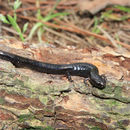Description
(
anglais
)
fourni par AmphibiaWeb articles
This is a moderately sized species; adult standard length averages 21.9 mm in 10 males (range 19.9-23.6) and 23.7 mm in 14 females (range 19.4-26.7). The head is relatively broad in males; SL averages 6.9 times head width (range 6.3-7.5) but only moderately wide in females (mean 7.3, range 6.3-8.3). Jaw muscles are large and prominent; their outlines are very visible externally. Snouts are relatively short and bluntly rounded or pointed. Nostrils are oval and of moderate size for the genus; the mean ratio of major to minor axes equals 1.4 in both sexes (range 1.2-1.7 in males, 1.1-1.6 in females). Eyes are large and protrude slightly beyond the margin of the jaw in dorsal view. A suborbital groove intersects the lip on each side of the head. There are 2-3 premaxillary teeth in adult males (mean 2.1) and 4-6 (mean 5.4) in females. Maxillary teeth average 14.8 in males (range 7-20) and 24.2 in females (range 19-29). Vomerine teeth average 9.2 in males (range 6-13) and 8.8 (range 5-12) in females. Limbs are moderately long; limb interval averages 4.5 in males (range 4-5.5) and 5.2 in females (range 4-6). Hands and feet are narrow. Digits are syndactylous; only the two longest fingers and three longest toes are free at their tips, which are pointed to bluntly pointed. Fingers, in order of decreasing length, are 3-2-4-1; toes are 3-(2-4)-5-1. The tail is stout and tapers posteriorly. It is rounded in cross section and only rarely exceeds standard length; mean SL divided by tail length equals 1.09 in males (range 0.93-1.35) and 1.02 in females (range 0.91-1.08). The mental gland is present in large adult males and is round to moderately elliptical (maximum dimensions: 1.1 mm wide, 1.3 mm long). The postiliac gland is prominent externally. Most specimens have a prominent, brown-to-tan dorsal stripe that is bordered on each side by a dark, wavy line. Chevrons are found within the stripe of some specimens. Conspicuous light spots are present ventrally, including the gular region and belly, and the tip of the snout usually is white. The iris is dark brown.Color in life, based on field notes by J. Hanken for MVZ 183094-118, 187091-97, and 187102, and by J. F. Lynch for MVZ 114606, 114609, 114612, 114614-15, 114618, 114624, 114631, and MZFC 8598-99 (all from Xometla): The dorsal stripe ranges from brown, to tan, to golden; lateral regions are blackish grey; the venter is a medium brownish gray. Conspicuous white flecks are concentrated at the chin, on lateral portions of the venter, and on the underside of the tail (Hanken and Wake 1998).Etymology. The species name is a conjunction of two Greek words, spilos (a spot, blemish) and gaster (the belly, stomach), in reference to the characteristic spotted ventral coloration. The name has been used informally by herpetologists in reference to this species for more than 25 years; its exact origin is unknown (J. Kezer, personal communication) (Hanken and Wake 1998).
Gadow, H. (1905). ''The distribution of Mexican amphibians and reptiles.'' Proceedings of the Zoological Society of London, (2), 191-244.
Distribution and Habitat
(
anglais
)
fourni par AmphibiaWeb articles
Thorius spilogaster is known from localities near the villages of El Berro and Xometla, Veracruz, Mexico, on the south and southeast flanks of Volcán Orizaba. It is sympatric with T. lunaris at both sites but has not been collected near Texmola, a village west of El Berro that is a third locality for T. lunaris. Recorded elevations range from 2500 to 2725 m (9-10000 ft according to Gadow 1905). According to field notes by J. Hanken, both species were collected at El Berro (3 Feb. 1976) along the north-facing wall of a canyon within the few remaining clumps of pine-oak forest (most of the canyon slope was otherwise cleared for farming). At Xometla (23 July 1976), they were found in partially cut-over pine forest. In spite of warm and dry conditions on both days, 50-60 adults were taken at each locality from terrestrial microhabitats under the bark of stumps, under large fallen logs, and especially within piles of wood chips and shavings. According to D. B. Wake, the two species were equally common at Xometla on 2 April 1970, when he and R. W. McDiarmid observed more than 300 specimens in apparently identical microhabitats (small surface cover and leaf litter). J. F. Lynch (22 Jan. 1974) did not detect any microhabitat differences between the two species at Xometla, but noted T. spilogaster as being slightly more common than T. lunaris (38 of 63 specimens observed) (Hanken and Wake, 1998).
Thorius spilogaster
(
basque
)
fourni par wikipedia EU
(RLQ=window.RLQ||[]).push(function(){mw.log.warn("Gadget "ErrefAurrebista" was not loaded. Please migrate it to use ResourceLoader. See u003Chttps://eu.wikipedia.org/wiki/Berezi:Gadgetaku003E.");});
- licence
- cc-by-sa-3.0
- droit d’auteur
- Wikipediako egileak eta editoreak
Thorius spilogaster: Brief Summary
(
basque
)
fourni par wikipedia EU
Thorius spilogaster Thorius generoko animalia da. Anfibioen barruko Plethodontidae familian sailkatuta dago, Caudata ordenan.
- licence
- cc-by-sa-3.0
- droit d’auteur
- Wikipediako egileak eta editoreak
Thorius spilogaster: Brief Summary
(
vietnamien
)
fourni par wikipedia VI
Thorius spilogaster là một loài kỳ giông trong họ Plethodontidae. Nó là loài đặc hữu của México.
Môi trường sống tự nhiên của chúng là các khu rừng vùng núi ẩm nhiệt đới hoặc cận nhiệt đới. Nó bị đe dọa do mất môi trường sống.
- licence
- cc-by-sa-3.0
- droit d’auteur
- Wikipedia tác giả và biên tập viên

